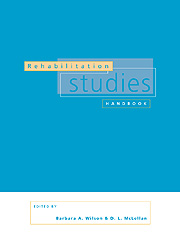Book contents
- Frontmatter
- Contents
- List of contributors
- 1 Introduction to rehabilitation
- 2 Disabled people in society
- 3 Disability equality training
- 4 Towards a therapeutic alliance model of rehabilitation
- 5 Rehabilitation education: a learner-centred approach
- 6 Work, occupation and disability
- 7 Management in rehabilitation
- 8 Research and evaluation in rehabilitation
- 9 Statistical methods
- 10 Social policy, disability and rehabilitation
- 11 Principles of the acquisition of sensorimotor skills
- 12 Management of acquired cognitive disorders
- 13 Challenging behaviour: helping people with severe brain damage
- 14 Pain
- 15 The multiply handicapped child
- 16 The transition to adult life
- 17 Factors specific to disabled elderly people
- Index
15 - The multiply handicapped child
Published online by Cambridge University Press: 06 November 2009
- Frontmatter
- Contents
- List of contributors
- 1 Introduction to rehabilitation
- 2 Disabled people in society
- 3 Disability equality training
- 4 Towards a therapeutic alliance model of rehabilitation
- 5 Rehabilitation education: a learner-centred approach
- 6 Work, occupation and disability
- 7 Management in rehabilitation
- 8 Research and evaluation in rehabilitation
- 9 Statistical methods
- 10 Social policy, disability and rehabilitation
- 11 Principles of the acquisition of sensorimotor skills
- 12 Management of acquired cognitive disorders
- 13 Challenging behaviour: helping people with severe brain damage
- 14 Pain
- 15 The multiply handicapped child
- 16 The transition to adult life
- 17 Factors specific to disabled elderly people
- Index
Summary
Introduction
Children with a neurological multiple handicap have incurred irreversible damage to the central nervous system (CNS) which may involve a variety of motor and sensory deficits and include disorders of cognition, behaviour and consciousness. In addition there may be secondary biochemical constraints resulting from the primary impairment that further incapacitate the children.
Neurological damage can occur prenatally, perinatally and postnatally. Prenatal causes include genetic abnormalities, congenital malformations and in utero infections. Perinatal birth trauma contributes to multiple handicap but improved imaging techniques and recording of apgar scores suggest that this is not common. Infection, vascular insufficiency and postconvulsive problems are potential postnatal factors. In many cases the cause of multiple handicap in children, however, is simply not known (Nelson & Ellenberg, 1986).
Following damage to the CNS, compensatory synaptic formation between neurones can occur within one day. In adults it frequently occurs within five days (Cotman & Nieto-Sampedro, 1985). The catalyst for this process is thought to be the presence of an environmental stimulus. In children, normal maturation is likely to confound these compensatory mechanisms. The timing of neurological damage is crucial as the effect appears to be as dependent on the stage of development at the time of injury as on its specific nature.
The four outstanding biological achievements of humans which separate them from other animals are:
Upright posture which facilitates locomotion while leaving the hands free.
Finely adjustable vision and flexible digits enabling the construction and use of tools.
[…]
- Type
- Chapter
- Information
- Rehabilitation Studies Handbook , pp. 315 - 354Publisher: Cambridge University PressPrint publication year: 1997
- 4
- Cited by



